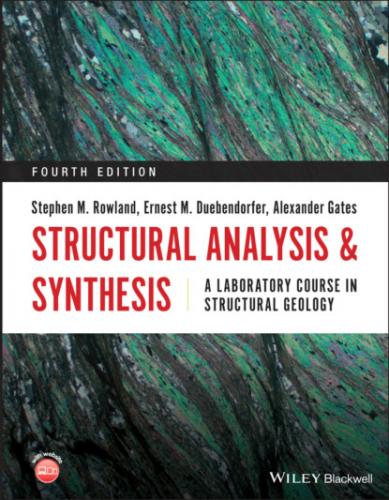242 254
243 255
244 256
245 257
246 258
247 259
248 260
249 261
250 262
251 263
252 265
253 266
254 267
255 268
256 269
257 270
258 271
259 272
260 273
Structural Analysis and Synthesis
A Laboratory Course in Structural Geology
Fourth Edition
Stephen M. Rowland
University of Nevada, Las Vegas
United States
Ernest M. Duebendorfer
Northern Arizona University
Arizona
United States
Alexander Gates
Rutgers University, Newark
New Jersey
United States
This fourth edition first published 2021
© 2021 John Wiley & Sons Ltd
Edition History 1e, (Blackwell Publishing Ltd, 1986); 2e, (Blackwell Publishing Limited, 1996); 3e, (Blackwell Publishing Ltd, 2007)
All rights reserved. No part of this publication may be reproduced, stored in a retrieval system, or transmitted, in any form or by any means, electronic, mechanical, photocopying, recording or otherwise, except as permitted by law. Advice on how to obtain permission to reuse material from this title is available at http://www.wiley.com/go/permissions.
The right of Stephen M. Rowland, Ernest M. Duebendorfer, and Alexander Gates to be identified as the authors of this work has been asserted in accordance with law.
Registered Offices John Wiley & Sons, Inc., 111 River Street, Hoboken, NJ 07030, USA John Wiley & Sons Ltd, The Atrium, Southern Gate, Chichester, West Sussex, PO19 8SQ, UK
Editorial Office 9600 Garsington Road, Oxford, OX4 2DQ, UK
For details of our global editorial offices, customer services, and more information about Wiley products visit us at www.wiley.com.
Wiley also publishes its books in a variety of electronic formats and by print-on-demand. Some content that appears in standard print versions of this book may not be available in other formats.
Limit of Liability/Disclaimer of Warranty While the publisher and authors have used their best efforts in preparing this work, they make no representations or warranties with respect to the accuracy or completeness of the contents of this work and specifically disclaim all warranties, including without limitation any implied warranties of merchantability or fitness for a particular purpose. No warranty may be created or extended by sales representatives, written sales materials or promotional state-ments for this work. The fact that an organization, website, or product is referred to in this work as a citation and/or potential source of further information does not mean that the publisher and authors endorse the information or services the organization, website, or product may provide or recommendations it may make. This work is sold with the understanding that the publisher is not engaged in rendering professional services. The advice and strategies contained herein may not be suitable for your situation. You should consult with a specialist where appropriate. Further, readers should be aware that websites listed in this work may have changed or disappeared between when this work was written and when it is read. Neither the publisher nor authors shall be liable for any loss of profit or any other commercial damages, including but not limited to special, incidental, consequential, or other damages.
Library of Congress Cataloging-in-Publication Data
Names: Rowland, Stephen Mark, author. | Duebendorfer, Ernest M., author. | Gates, Alexander E., 1957– author.
Title: Structural analysis and synthesis : a laboratory course in structural geology / Stephen M. Rowland, University of Nevada, Las Vegas, Ernest M. Duebendorfer, Northern Arizona University, Arizona, Alexander Gates, Rutgers University, New Jersey.
Description: Fourth edition. | Hoboken, NJ : Wiley-Blackwell, 2021. | Includes bibliographical references and index.
Identifiers: LCCN 2020025025 (print) | LCCN 2020025026 (ebook) | ISBN 9781119535454 (paperback) | ISBN 9781119535461 (adobe pdf) | ISBN 9781119535485 (epub)
Subjects: LCSH: Geology, Structural–Laboratory manuals.
Classification: LCC QE501 .R73 2021 (print) | LCC QE501 (ebook) | DDC 551.8078–dc23
LC record available at https://lccn.loc.gov/2020025025 LC ebook record available at https://lccn.loc.gov/2020025026
Cover Design: Wiley
Cover Images: © Alexander Gates
Preface
This manual is intended to serve as the primary resource for the laboratory portion of an introductory course in structural geology for undergraduate students. It is designed to accompany any of the available structural geology textbooks. It supports both the descriptive and quantitative parts of a course at approximately the same level of detail as most of the textbooks. The book retains 17 chapters to cover the standard 12–14 weeks of a semester, and several chapters have specialized themes. The organization by the authors places most of the areas deemed necessary to structural geology at the front of the manual, followed by a synthesis of most of them, and then the more specialized topics at the end.
One of the most challenging aspects of structural geology for introductory students is visualizing three‐dimensional structural features and objects and representing them or projecting them on two‐dimensional diagrams for analysis. This is still the case even with computer programs to solve simple to complex problems. Students are strongly encouraged to use props to help visualize the real‐world features rather than trying to imagine them. The exercises are much easier to solve and the methods understood using this approach.
The other challenge for students is that many techniques build upon previously learned techniques. It is imperative for students to complete the supporting exercises and fully understand them before moving to the next level of rigor, or the deficits will snowball. This is especially true with the equal‐area projections which are used in multiple chapters. For this reason, all of the exercises should be done manually at their introduction. After students master the manual techniques, they are encouraged to use computers.
The final challenge for which many students find problems
